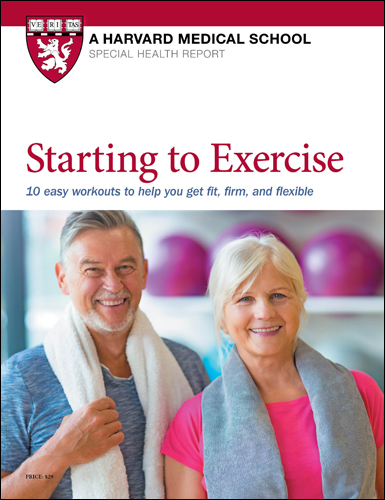Exercise may heal the heart as well as prevent future problems
A daily walk and twice-weekly strength training can help to reverse heart stiffness and improve cardiovascular health.

When it comes to heart health, a lot of the focus is rightly on prevention. Eat right and exercise, and you'll have a healthier heart when you get older. But what if you're already older and your heart is showing signs of trouble? Is exercise going to do anything to help you?
As it turns out, the answer may be yes.
"Because physical activity has physiological benefits for the heart, it can not only help prevent, but also reverse some of the earlier damage to the heart and blood vessels," says Dr. JoAnn Manson, the Michael and Lee Bell Professor of Women's Health at Harvard Medical School.
One study, published Sept. 21, 2021, in the journal Circulation, showed that a yearlong exercise program helped improve heart health in people who had heart-related changes that put them at increased risk for heart failure.
People in the study had a condition called left ventricular hypertrophy, which is a thickening of the left chamber of the heart. This condition makes it harder for it to pump blood efficiently. They also had elevated levels of cardiac biomarkers — certain chemicals in the blood that indicate heart injury or increased risk of heart failure. People with these conditions often go on to develop a specific type of heart failure, called heart failure with preserved ejection fraction. The study's authors set out to see if exercise could help improve heart health in this situation.
The researchers enrolled 46 people between the ages of 45 and 64 and randomly assigned them to either a year of high-intensity exercise training or to a control group, whose members did yoga, balance training, and light resistance exercises.
Those in the exercise group got individualized exercise plans based on their fitness levels, worked with a personal trainer, and used heart rate monitors. They walked, swam, or cycled at least three times a week for 30 to 60 minutes. They used a strategy called interval training, which involves alternating between short periods of vigorous exercise and lower-intensity periods throughout a workout, and which has been shown to lead to larger improvements in cardiovascular fitness compared with other types of exercise. The exercisers also did strength training once or twice per week.
All of the participants underwent heart imaging and tests designed to assess the flexibility of their heart muscle at the start of the trial and again at the end of the training program. After a year, the researchers found that the hearts of the people who participated in the exercise program had become less rigid and were more efficient at pumping blood than those of the control group members. The researchers said that this led them to believe that exercise training could help protect against heart failure, but they added that a year wasn't enough time to assess long-term outcomes and more study is needed.
Exercise and the heart
It's not surprising that the researchers found improvements, given all the heart-related benefits of exercise, such as reducing blood pressure, says Dr. Manson.
"If you are already healthy, exercise can keep you that way. But exercise can also help you lose weight, decrease damaging inflammation inside your body, reduce insulin resistance, and improve your blood flow," she says. "All of those things could help reduce cardiac stiffness."
Research has also shown that sitting around for long periods of the day and a lack of regular physical activity can take a toll on heart health. A sedentary lifestyle can lead to weight gain, a higher risk of hypertension, diabetes, and high cholesterol. These conditions, in turn, increase the risk of atherosclerosis, heart attack, stroke, heart failure, and even atrial fibrillation (a type of irregular heartbeat), says Dr. Manson. They are all interrelated.
"Physical activity is probably as close as we've come to a magic bullet for good health," she says. "It can favorably influence multiple biological pathways and risk factors very early in the process to prevent development of diabetes, obesity, and atherosclerosis. As a result, you will have a much lower risk of heart attack and stroke."
Even at the molecular level there are many benefits to regular exercise, she says. It improves the ability of the cells to respond to insulin and can enhance the function of blood vessels — for example, by improving their ability to dilate. Physical activity also reduces inflammation within the blood vessels, the body, and tissues.
It's not too late to get your heart into shapeNo matter when you start exercising or what condition you're in when you start, know that it can improve your health, even if you already have heart problems. "Cardiac rehabilitation is extremely beneficial in reducing cardiovascular death in people who have had heart attacks or heart failure," says Dr. JoAnn Manson, the Michael and Lee Bell Professor of Women's Health at Harvard Medical School. And remember, even if you have a family history of cardiovascular disease, that doesn't necessarily mean you will end up going down the same road. "The point that I often make is that heredity isn't destiny. Many people do have a family history of heart disease and certain medical conditions. They think they're predestined to develop these problems, too. But one of the most important things you can do in terms of modifying your risk and taking control of your health is to be physically active," says Dr. Manson. Ultimately there are two things that people should remember when it comes to exercise: "It's never too late to start, and it's also never too early to start," says Dr. Manson. |
What type and how much?
A heart-healthy exercise program is one that includes both cardiovascular exercise and strength training, says Dr. Manson. If you've had a heart attack or are at high risk for cardiovascular problems, it's best to run your exercise program by your doctor before you get started.
"Walking is typically a great option for most people, regardless of their health history," says Dr. Manson. She points to a study, published online Sept. 3, 2021, by JAMA Network Open, that found that people who took 7,000 or more steps a day were less likely to die prematurely than those who came in under that 7,000-step mark.
Researchers asked 2,110 participants ages 38 to 50 to wear a tracking device for seven consecutive days. They were divided into low, moderate, and high step groups and then followed for an average of almost 11 years. In that time, 72 people died. The researchers found that people who took fewer steps — less than 7,000 a day — were more likely to die during the follow-up period than those who were in the moderate (7,000 to 9,999) or high (10,000 or more) daily step ranges. Walking intensity didn't seem to affect death rates.
In general, people should aim to do at least 30 minutes a day of walking, which adds up to 150 minutes of moderate to vigorous activity each week. However, if you're at increased risk of cardiovascular disease due to risk factors such as hypertension, you should aim for more — closer to 45 minutes over the course of the day, says Dr. Manson. If you are trying to lose weight, try to fit in 45 to 60 minutes a day.
"It definitely doesn't have to be done at the same time. Break it into 10- to 15-minute bouts of exercise several times a day," she says.
Strength training twice a week is also recommended.
Also try to minimize the amount of sitting around you're doing during the day. Sitting for nine to 10 hours a day has been linked to increased heart risks, says Dr. Manson. If you work at a computer, get up and walk around at regular intervals (such as every 30 to 60 minutes), invest in a standing desk, or walk when you are on the phone.
"You can still be active even when you have a desk job," says Dr. Manson.
Regular exercise can offset many of the risks of sitting. "You can mitigate some of that risk by being physically active at other times of the day," she says.
Image: © FatCamera/Getty Images
About the Author

Kelly Bilodeau, Former Executive Editor, Harvard Women's Health Watch
Disclaimer:
As a service to our readers, Harvard Health Publishing provides access to our library of archived content. Please note the date of last review or update on all articles.
No content on this site, regardless of date, should ever be used as a substitute for direct medical advice from your doctor or other qualified clinician.
















